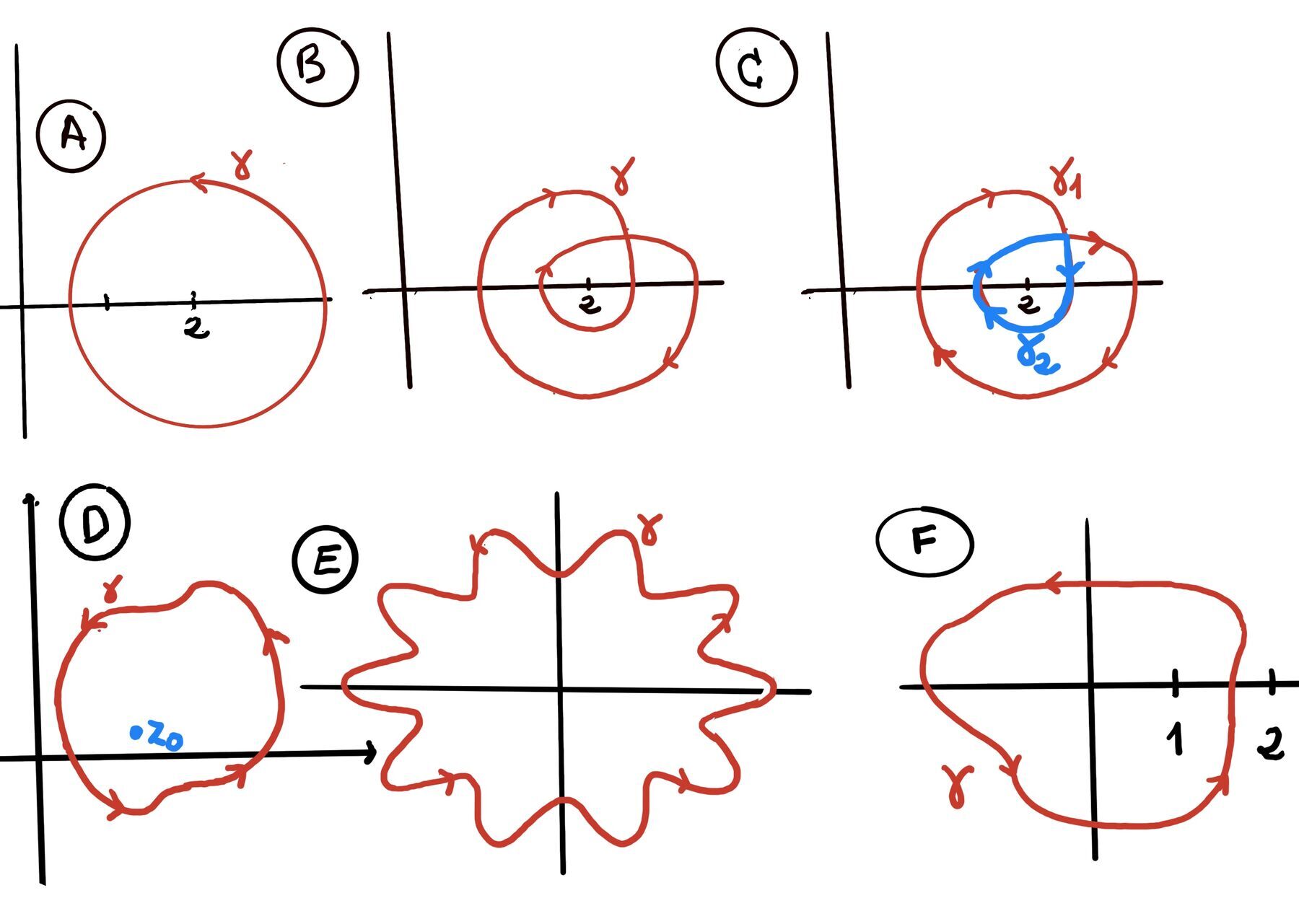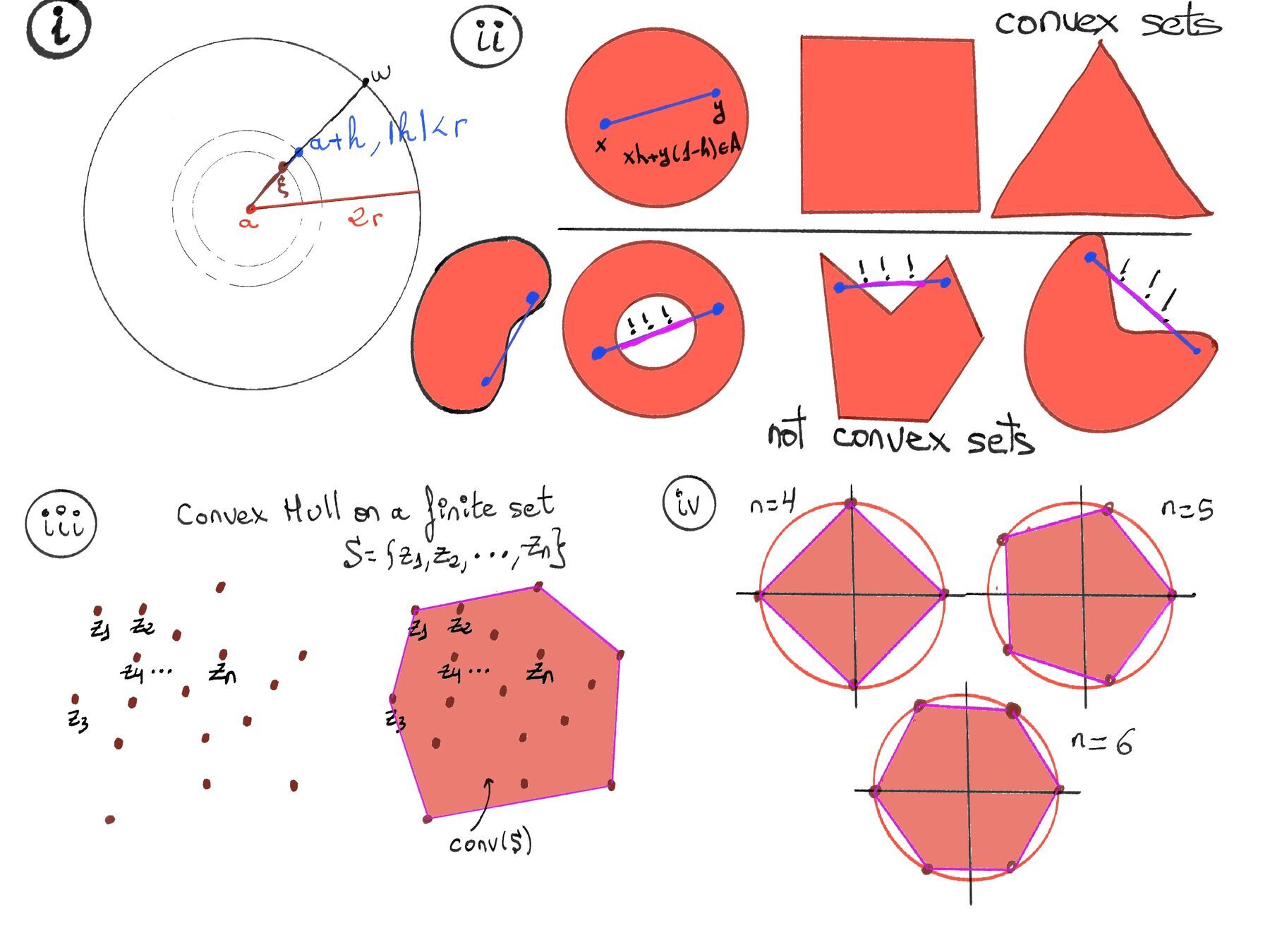
|
 |
 |
All things are difficult before they are easy, Thomas Fuller.

A complex function $f(z)$ maps $z = x + iy \in \mathbb{C}$ to another complex number. For example: $f(z) = z^2 = (x + iy)^2 = x^2 - y^2 + 2ixy, f(z) = \frac{1}{z}, f(z) = \sqrt{z^2 + 7}$.
A contour is a continuous, piecewise-smooth curve defined parametrically as: $z(t) = x(t) + iy(t), \quad a \leq t \leq b$. Examples of contours:
Definition (Smooth Contour Integral). Let ᵞ be a smooth contour (a continuously differentiable path in the complex plane), $\gamma: [a, b] \to \mathbb{C}$. Let $f: \gamma^* \to \mathbb{C}$ be a continuous complex-valued function defined on the trace $\gamma^*$ of the contour (i.e. along the image of $\gamma$). Then, the contour integral of f along $\gamma$ is defined as $\int_{\gamma} f(z)dz := \int_{a}^{b} f(\gamma(t)) \gamma^{'}(t)dt$.
In this definition, we integrate the function f along the path traced out by $\gamma(t)$. The term $\gamma^{'}(t)$ (the derivative of $\gamma$) accounts for the direction and speed of traversal along the path. This definition essentially transforms or converts the complex line integral into a regular real integral over the interval [a, b] via the parametrization $\gamma(t)$. The factor $\gamma'(t)dt = d\gamma$ represents an infinitesimal step along the curve, so $f(\gamma(t))\gamma'(t)dt$ is the infinitesimal contribution to the integral from that step.
Theorem. Cauchy Integral Formula. If a function f is analytic in a simply connected domain D and γ is a simply closed contour (positive orientated) in D. Then, for any point $z_0$ inside γ we have $f(z_0) = \frac{1}{2\pi i}\cdot \int_{\gamma} \frac{f(z)}{z-z_0}dz$ (Figure D).

It states that the value of an analytic function at any point z₀ is completely determined by the values the function takes on any simple closed curve that encircles the point. If you know the function’s values on the boundary, you know everything about the function’s behavior inside that boundary. This is quite unlike anything you’ve probably encountered with functions of real variables.
A more generalized version is as follows: $f^{(n)}(z_0) = \frac{n!}{2\pi i}\cdot \int_{\gamma} \frac{f(z)}{(z-z_0)^{(n+1)}}dz$.
Cauchy Integral Formula (Winding Number Lemma). Let γ be a closed rectifiable curve in ℂ, f analytic on an open set containing γ and its interior. For any point a not on γ, the Cauchy Integral Formula states: $\oint_{\gamma} \frac{f(z)}{z-a}dz = 2\pi i \cdot n(\gamma, a) \cdot f(a)$
The winding number is defined as $n(γ, a) = \frac{1}{2πi}\oint_\gamma \frac{dz}{z-a}$. This represents the net number of times γ winds around a counterclockwise.
For simple closed curves with positive orientation n(γ, a) = 1 if a is inside γ, 0 if outside.
For multiple windings n(γ, a) counts the net winding (e.g., 2 for two counterclockwise loops, -1 for one clockwise loop).
The formula reduces to the basic Cauchy Integral Formula when n(γ, a) = 1.
The formula can be used to calculate integrals: $\int_{\gamma} \frac{f(z)}{z-z_0}dz = 2\pi i \cdot f(z_0), \int_{\gamma} \frac{f(z)}{(z-z_0)^{(n+1)}}dz = \frac{2\pi i}{n!} \cdot f^{(n)}(z_0)$
Key Conditions:
Analyticity: $ f(z) $ must be analytic (holomorphic) inside and on $\gamma$.
Contour $ C $: $\gamma$ is a simple closed curve (e.g., a circle, ellipse). A simple closed curve is a curve that has no self-intersections and is closed, meaning it starts and ends at the same point.
Point $z_0$: $z_0$ must lie inside $\gamma$. If $z_0$ is outside $\gamma$, the integral is zero.
General Cauchy Integral Formula for Derivatives. If f is analytic (holomorphic) on and inside a positively orientated simple closed contour $\gamma$ and a is a point inside $\gamma$, then for any non-negative integer n, the n-th derivative of f at a exists and is given by $f^{(n)}(a) = \frac{n!}{2\pi i}\oint_\gamma \frac{f(w)}{(w-a)^{n+1}}dw, \forall a \in \mathcal{Int}(\gamma)$
Key Conditions:
This is a powerful result in complex analysis because it expresses the n-th derivative of an analytic function entirely in terms of a contour integral around the point.
Rearranging the formula gives: $\oint_\gamma \frac{f(w)}{(w-a)^{n+1}}dw = \frac{2\pi i}{n!}f^{(n)}(a)$. This is just solving the original formula for the integral itself, and it’s often quite useful when evaluating complex integrals involving analytic functions. This is called the General Cauchy Integral Formula because it generalizes the original Cauchy Integral Formula to compute higher-order derivatives of analytic functions using contour integrals.
This is a classic example of using proof by induction.
Case n = 0 is the base case. $f(a) = \frac{0!}{2\pi i}\oint_\gamma \frac{f(w)}{(w-a)^{1}}dw$. This is the original Cauchy’s Integral Formula, which we assume is already proven.
Inductive Hypothesis, We assume the formula holds for the k-th derivative: $f^{(k)}(a) = \frac{k!}{2\pi i}\oint_\gamma \frac{f(w)}{(w-a)^{k+1}}dw$. Inductive Step. We must use the hypothesis to prove that $f^{(k+1)}(a)$ exists and that the formula holds for k + 1: $f^{(k+1)}(a) = \frac{(k+1)!}{2\pi i}\oint_\gamma \frac{f(w)}{(w-a)^{k+2}}dw$
The basic tool we have to find $f^{(k+1)}(a)$ is the fundamental limit definition of the derivative, applied to $f^{(k)}(a)$ that is $f^{(k+1)}(a) = \lim_{h \to 0} \frac{f^{(k)}(a + h) - f^{(k)}(a)}{h}$
We can replace $\gamma$ by $\gamma(a; 2r)$ with a specific circle centered at $a$ with radius $2r$. By the Deformation Theorem, this doesn’t change the contour integral. We will use $\gamma$ and $\gamma(a; 2r)$ indistinguishably for simplicity’s sake.
$f^{(k)}(a + h)-f^{(k)}(a) =[\text{Inductive Hypothesis, n = k}] \frac{k!}{2\pi i}\oint_\gamma \frac{f(w)}{(w-(a+h))^{k+1}}dw - \frac{k!}{2\pi i}\oint_\gamma \frac{f(w)}{(w-a)^{k+1}}dw = \frac{k!}{2\pi i} \oint_{\gamma} f(w)[\frac{1}{(w -a - h)^{k+1}-(w -a)^{k+1}}]dw$
Consider the function F(ξ) = $\frac{1}{(w-ξ)^{k+1}}$. Its derivative with respect to $\xi$ is $F'(\xi) = (-k-1)(w-\xi)^{-k-2} \cdot (-1) = (k+1)(w-\xi)^{-k-2}$. By the Fundamental Theorem of Calculus, $\int_a^{a+h} F'(\xi)d\xi = F(a+h) - F(a)$.
In our particular case, $\int_a^{a+h} (k+1)(w-\xi)^{-k-2} d\xi = (w-(a+h))^{-k-1} - (w-a)^{-k-1} \leadsto \frac{1}{(w-a-h)^{k+1}} - \frac{1}{(w-a)^{k+1}} = (k+1) \int_{[a, a+h]} \frac{1}{(w-\xi)^{k+2}} d\xi$
$$ \begin{aligned} f^{(k)}(a + h)-f^{(k)}(a) &=\frac{k!}{2\pi i} \oint_{\gamma} f(w)[\frac{1}{(w -a - h)^{k+1}-(w -a)^{k+1}}]dw \\[2pt] &\text{Now we substitute this new integral back into our main expression:} \\[2pt] &=\frac{k!}{2\pi i} \oint_{\gamma} f(w)(\int_{[a, a+h]} \frac{k+1}{(w-ξ)^{k+2}}dξ)dw \\[2pt] &\text{We can bring the constant $(k+1)$ out to the front, which gives us (k + 1)!: } \\[2pt] &=\frac{(k+1)!}{2\pi i} \oint_{\gamma} (\int_{[a, a+h]} \frac{f(w)}{(w-ξ)^{k+2}}dξ)dw \\[2pt] &=\frac{(k+1)!}{2\pi i} \oint_{\gamma} f(w) (\int_{[a, a+h]} (w-ξ)^{-k-2}dξ)dw \end{aligned} $$We are trying to prove that $\lim_{h \to 0} \frac{f^{(k)}(a+h) - f^{(k)}(a)}{h}$ equals our target $\frac{(k+1)!}{2\pi i}\oint_{\gamma}\frac{f(w)}{(w-a)^{k+2}}$. Let’s look at the difference between the expression we have and the target we want:
$$ \begin{aligned} \text{Error Term} &=\frac{f^{(k)}(a + h)-f^{(k)}(a)}{h} - \frac{(k+1)!}{2\pi i}\oint_{\gamma}\frac{f(w)}{(w-a)^{k+2}} \\[2pt] &=\frac{(k+1)!}{2\pi i h} \oint_{\gamma} f(w) (\int_{[a, a+h]}(w-ξ)^{-k-2}dξ - h(w-a)^{-k-2})dw \\[2pt] &(w-a)^{-k-2} \text{ is constant with respect to ξ over the straight line [a, a+h]} \\[2pt] &=\frac{(k+1)!}{2\pi i h} \oint_{\gamma} f(w) (\int_{[a, a+h]}((w-ξ)^{-k-2} - (w-a)^{-k-2})dξ)dw \\[2pt] &\text{Let } H(\tau) = (w-\tau)^{-k-2}, H'(\tau) = (-k-2)(w-\tau)^{-k-3} \cdot (-1) = (k+2)(w-\tau)^{-k-3}. \\[2pt] &\text{By the Fundamental Theorem of Calculus } \int_a^\xi H'(\tau)d\tau = H(\xi) - H(a). \int_{[a, \xi]} (k+2)(w-\tau)^{-k-3} d\tau = (w-\xi)^{-k-2} - (w-a)^{-k-2}. \\[2pt] &=\frac{(k+1)!}{2\pi i h} \oint_{\gamma} f(w) (\int_{[a, a+h]}(\int_{[a, ξ]} (w-\tau)^{-k-3}(k + 2)d\tau)dξ)dw \end{aligned} $$Choose h to be small enough such that |h| < r. Bounding the Error with M L-Estimation: (Figure i)

We apply the bounds to the magnitude of the Error term:
$$ \begin{aligned} |Error| &=|\frac{f^{(k)}(a + h)-f^{(k)}(a)}{h} - \frac{(k+1)!}{2\pi i}\oint_{\gamma}\frac{f(w)}{(w-a)^{k+2}}| \\[2pt] &\le \frac{(k+1)!}{2\pi |h|} \oint_{\gamma} \int_{[a, a+h]} M \left( \int_{[a, \xi]} (k+2) \frac{1}{r^{k+3}} |d\tau| \right) |d\xi| |dw| \\[2pt] &\text{Inner τ-integral} \int_{[a, \xi]} (k+2) \frac{1}{r^{k+3}} |d\tau| = (k+2) \frac{1}{r^{k+3}} \cdot (\text{Length of } [a,\xi]) \le (k+2) \frac{1}{r^{k+3}} |h| \\[2pt] &\text{Inner ξ-integral} \int_{[a, a+h]} M \left( (k+2) \frac{1}{r^{k+3}} |h| \right) |d\xi| = M (k+2) \frac{|h|}{r^{k+3}} \cdot (\text{Length of } [a,a+h]) = M (k+2) \frac{|h|^2}{r^{k+3}}. \\[2pt] &\le \frac{(k+1)!}{2\pi |h|} \oint_{\gamma}\frac{M(k+2)}{r^{k+3}}|h|^2|dw| \\[2pt] &\text{Outer w-integral} \oint_{\gamma} \left( M (k+2) \frac{|h|^2}{r^{k+3}} \right) |dw| = M (k+2) \frac{|h|^2}{r^{k+3}} \cdot (\text{Length of } \gamma) = M (k+2) \frac{|h|^2}{r^{k+3}} (4\pi r). \\[2pt] &=\frac{(k+2)!}{2\pi |h|}\frac{M}{r^{k+3}}|h|^2 4\pi r \\[2pt] &=\frac{2(k+2)!}{r^{k+2}} M|h| \end{aligned} $$We have successfully shown that the magnitude of the Error term is bounded: $0 \le |\frac{f^{(k)}(a + h)-f^{(k)}(a)}{h} - \frac{(k+1)!}{2\pi i}\oint_{\gamma}\frac{f(w)}{(w-a)^{k+2}}| \le \frac{2(k+2)!}{r^{k+2}} M|h|$
$\lim_{h \to 0} 0 = \lim_{h \to 0} \frac{2(k+2)!}{r^{k+3}} M|h| = 0$. By the Squeeze Theorem, $\lim_{h \to 0} |\frac{f^{(k)}(a + h)-f^{(k)}(a)}{h} - \frac{(k+1)!}{2\pi i}\oint_{\gamma}\frac{f(w)}{(w-a)^{k+2}}| = 0.$ If the limit of the magnitude is 0, the limit of the term itself is 0. $\lim_{h \to 0} \frac{f^{(k)}(a + h)-f^{(k)}(a)}{h} - \frac{(k+1)!}{2\pi i}\oint_{\gamma}\frac{f(w)}{(w-a)^{k+2}} = 0 $
Since $\frac{(k+1)!}{2\pi i}\oint_{\gamma}\frac{f(w)}{(w-a)^{k+2}}$ is constant related to h and by the definition of the derivative, $f^{k+1}(a)$ exists, and is equal to the formula $f^{k+1}(a) = \lim_{h \to 0} \frac{f^{(k)}(a + h)-f^{(k)}(a)}{h} = \frac{(k+1)!}{2\pi i}\oint_{\gamma}\frac{f(w)}{(w-a)^{k+2}}$
The singularity is inside our contour, $z = 1 \in \mathcal{Int}(\gamma(0, 2))$.
$ =[\text{Define } f(z) = e^{z²}]= \oint_{\gamma(0, 2)} \frac{f(z)}{(z-1)^3} =[\text{General Cauchy Integral Formula, n = 2, z =1 }] \frac{2\pi i}{2!} f''(1) - $
$$ \begin{aligned} \oint_{\gamma(0, 2)} (z-1)^{-3}e^{z²} &[\text{ Define } f(z) = e^{z²}] \\[2pt] &=\oint_{\gamma(0, 2)} \frac{f(z)}{(z-1)^3} \\[2pt] &\text{General Cauchy Integral Formula, n = 2, z =1 } \\[2pt] &=\frac{2\pi i}{2!} f''(1) = \frac{2\pi i}{2}(\frac{d}{dz}(2ze^{z²}))\Big|_{z=1} \\[2pt] &=\pi i(2e^{z²} + 4z²e^{z²})\Big|_{z=1} = \pi i(2e + 4\cdot 1e) = 6e\pi i. \end{aligned} $$Solution.
This is a classic example how calculating contour integrals could be simplified quite a lot by using the Cauchy Integral Formula for Derivatives.
Let’s consider our integrand’s numerator f(z) = $e^{z^2}$, our contour integral becomes
$$ \begin{aligned} \oint_{\gamma} \frac{e^{z^2}}{(z-i)^4}dz &=\oint_{\gamma} \frac{f(z)}{(z-i)^4}dz \\[2pt] &\text{By the Deformation Theorem}\\[2pt] &=\oint_{\gamma(i, 1)} \frac{f(z)}{(z-i)^4}dz \\[2pt] &\text{By the Cauchy Integral Formula for Derivatives: (the order is n = 3, the singularity inside the contour is a = i) } f^{(n)}(a) = \frac{n!}{2\pi i} \oint_{\gamma} \frac{f(z)}{(z-a)^{n+1}}dz \\[2pt] &=2\pi i \frac{f^{'''}(i)}{3!} \\[2pt] &[f'(z) = 2ze^{z^2}, f''(z) = 2e^{z^2} + 4z^2e^{z^2}, f'''(z) = 2e^{z^2}2z + 8ze^{z^2} + 8z^3e^{z^2} = 12ze^{z^2} + 8z^3e^{z^2}] \\[2pt] &\text{ We plug the value of f'''(i) back into our formula: } f'''(i) = 12ie^{-1} - 8ie^{-1}=\frac{4i}{e} \\[2pt] &=\frac{2\pi i}{6}\cdot \frac{4i}{e} = -\frac{4\pi}{3e} \end{aligned} $$